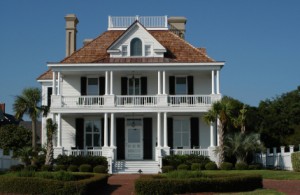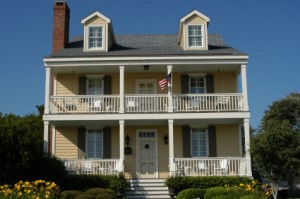 Visitors to Wilmington, NC often marvel at the beautiful architecture of our historic downtown and the many elegant homes with large windows, iron gates, and gracious porches. One quintessential feature of these homes is the lovely plantation shutters that grace their windows and still inspire custom home designers today. While today’s plantation shutters are more decorative, the history of plantation shutters tells us that they served many functional purposes and made homes more comfortable and pleasant.
Visitors to Wilmington, NC often marvel at the beautiful architecture of our historic downtown and the many elegant homes with large windows, iron gates, and gracious porches. One quintessential feature of these homes is the lovely plantation shutters that grace their windows and still inspire custom home designers today. While today’s plantation shutters are more decorative, the history of plantation shutters tells us that they served many functional purposes and made homes more comfortable and pleasant.
A Classical Tradition: Greek shutters
Many say that the Greeks invented shutters with fixed slats made of marble. If they indeed existed, these expensive shutters were likely reserved for the elite; wooden shutters eventually came to be used as a more affordable alternative. Fixed louvered shutters remain a popular part of Greek architecture today. For example, the picturesque island of Paros, a popular location for travelers, is known for its whitewashed stone houses. These striking homes are usually decorated with blue doors and blue shutters made of wood, giving the island a beautiful picture-postcard look.
The island of Paros was famous in the ancient era for its Parian marble, which was used for famous sculptures, such as the Nike of Samothrace, which is now in the Louvre museum in Paris. Perhaps Parian marble may have been used in the construction of wealthy homes with shutters just as it was used in many celebrated works, including the Medici Venus, the roof tiles of the Parthenon, and the tomb of Napoleon.
Adding Ooh La La: French shutters
Later, when shutters were introduced in Europe, they developed more of the elegance they’re known for today, as artisans explored ways to make them more functional. The popularization of louvered shutters is usually credited to French royalty, especially Louis XIV, the Sun King. Even the name “louvre,” referring to the adjustable horizontal slats that characterize today’s plantation shutters, is of French origin. It may be derived the former royal palace of The Louvre, now a world famous art museum.
Many dictionaries say that the term “louvre” was first used to refer to medieval turrets that helped ventilate rooms, while providing coverage, just as these shutters let in light while blocking winds and other elements of inclement weather. The addition of adjustable slats to shutters allowed them to be used for protection while preserving some light and visibility for inside buildings.
Gracious Living: Southern shutters
 Often, Americans associate the South, land of sultry breezes and beautiful mansions, with plantation shutters. Did you know that these shutters served a functional purpose as well? The warmth of the South’s climate led to the development of many of the region’s signature architectural elements, like multilevel porches and plantation shutters. These elements provided ventilation for residents while helping to ward off mosquitoes, crucial in a period when malaria was a common concern.
Often, Americans associate the South, land of sultry breezes and beautiful mansions, with plantation shutters. Did you know that these shutters served a functional purpose as well? The warmth of the South’s climate led to the development of many of the region’s signature architectural elements, like multilevel porches and plantation shutters. These elements provided ventilation for residents while helping to ward off mosquitoes, crucial in a period when malaria was a common concern.
As a result, nineteenth century southern homes often featured large windows with plantation shutters. Such windows could be opened on several sides of a room, allowing breezes through, while the shutters blocked the heat of the sun. At the historical plantation homes that now serve as public museums in Wilmington, NC, rumor has it that nineteenth-century taxes on doors, in particular, led to a fashion for larger windows that could be opened and walked through without requiring increased taxes. Ironically, many plantation homes were inspired by the nineteenth century fashion for neoclassical and Greek revival architecture—homes with columns and decorative elements inspired by ancient Greece and Rome.
The plantation shutter has traveled far from its origins in ancient Greece. However, it remains a symbol of elegance and functionality. Want to see what plantation shutter options are available for your home? Visit our showroom on 23rd Street in Wilmington, NC today.